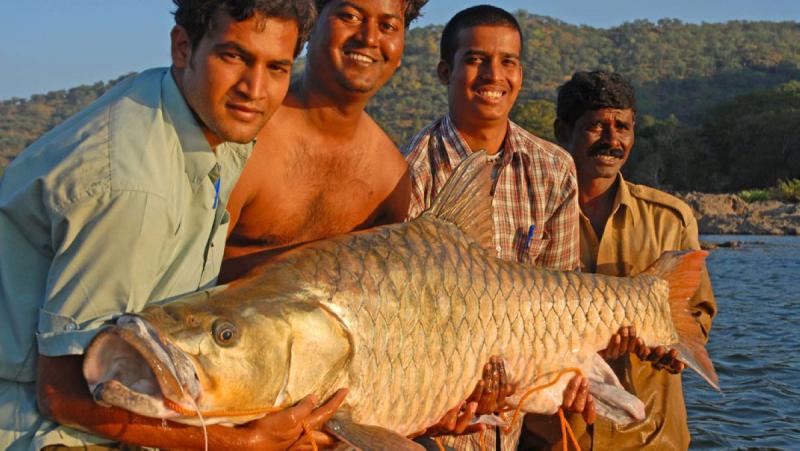
Henry Sullivan Thomas’ book A Rod in India, published in 1873, talks about the tricks of the trade for sport-fishing in India. One of the iconic game fish mentioned in this book is the hump-backed mahseer, a huge carp that can grow up to 1.5 metres in length and weigh about 55 kg! This massive fish is native to South India and is known to anglers around the globe as ‘one of the largest, hardest fighting and most iconic freshwater game fish in the world’. For the next 145 years, that is all we knew about this fish—there was no scientific name or identification!
Thanks to an extensive body of research led by scientists from Bournemouth University UK, we now know that this giant carp is endemic to the waters of the river Cauvery and its tributaries. We also know that due to a restricted natural distribution and a range of escalating environmental pressures, its survival is currently uncertain, and is on the verge of extinction. In a recently published study, the researchers have taken the first step of scientifically naming the fish as Tor remadevii, with a hope of reviving its numbers.
“It was just unbelievable that such an enormous animal, recognised by anglers around the world, could be about to go extinct in advance of being afforded a scientific name”, says Adrian Pinder, the lead researcher from Bournemouth University. He is also the Director of Research at the Mahseer Trust, a charity set up to conserve mahseer species and their environment.
But, what’s in a name, you ask? The lack of a formal scientific name means that the iconic hump-backed mahseer does not figure on the IUCN Red List of Threatened Species—the world's most comprehensive list of the global conservation status of plants and animals. In the absence of a specific conservation status, there is no monitoring of the fish numbers, and no steps can be taken to save them.
The increasing instances of dynamite fishing, where explosives are used to kill a large school of fish, and the construction of dams and embankments along the river Cauvery, have caused severe damage to the habitats of the hump-backed mahseer. Data from the historical catch records of this fish, collected by anglers, show that since 2004, there has been a dramatic crash in the population of this fish, pushing it towards extinction.
“We knew something needed to be done to support the survival of this species. The alarming and rapid loss of this iconic species from the majority of the Cauvery system has deeper conservation implications. Indeed, as an ‘indicator species’ and an apex predator, the loss of the humpback will have knock-on ramifications for the broader biodiversity of the river”, remarks Adrian.
As a first step towards giving the fish a scientific name, the researchers set out to collect the specimens of the fish needed for classification. They set up a team involving scientists from the three states through which the river Cauvery flows—Karnataka, Kerala and Tamil Nadu—to find the fish and collect data regarding the body measurements and DNA samples.
“Our big problem was that by the time, we realised that this fish was close to extinction and we had the additional challenge of finding specimens”, shares Adrian.
The researchers worked with the local tribal community and fisherfolk to find a small population of humpbacks in the isolated river Moyar in Tamil Nadu.
The analyses showed that the DNA sequence of the hump-backed mahseer was unique, distinguishing it from all other previously described species of mahseer. The findings led the researchers to believe that they had indeed identified a new species until they came across a 2007 study that described a new species of mahseer called Tor remadevii. However, this description was insufficient in detail and based only on a sample of small juvenile fish from Pambar, a tributary of river Cauvery which flows through the states of Kerala and Tamil Nadu.
Intrigued, the researchers then set out to investigate the geographic origin of Tor remadevii and examined the museum specimens in detail. The results of these investigations confirmed that the hump-backed mahseer was, in fact, conspecific with Tor remadevii. The researchers then published their findings in the journal PLOS ONE.
The news of this discovery triggered an emergency meeting with experts from the International Union for Conservation of Nature (IUCN) in Pune and a draft of the Red List assessment of Tor remadevii was generated, with the species qualifying as ‘Critically Endangered’. “This will be a pivotal move in securing much-needed protection and immediate conservation planning to save the species from extinction”, explains Adrian.
“The hump-backed mahseer could probably be the most restricted of all mahseer species and is now the most threatened, requiring urgent conservation attention, both in-situ and ex-situ”, stresses Dr. Rajeev Raghavan, Assistant Professor at the Kerala University of Fisheries and Ocean Studies (KUFOS), and IUCN’s Freshwater Fish Red List Authority Coordinator, who is also the co-author of the study.
“Securing the future of the hump-backed mahseer will depend on the strong willingness and cooperation of a range of stakeholders from three southern Indian States; Kerala, Tamil Nadu and Karnataka, in one of India’s most contested rivers—the Cauvery”, he adds.
“When we think of endangered species, we often think of ‘flagship’ species such as the Giant Panda and Bengal tiger, which are currently and respectively assessed on the IUCN Red List as ‘Vulnerable’ and ‘Endangered’. However, with the hump-backed mahseer, we are talking about a creature which is more imperilled that these better-known icons. Now that we have verified the scientific name and can officially categorise the perilous conservation status of this fish, we can continue to take affirmative steps to ensure its survival long into the future”, says Adrian, about the implications of this study.
This article is based on a press release from Bournemouth University, UK. Here is a link to a short video from Adrian Pinder, explaining more about the study and its importance.





